Related Research Articles

Barnabas, born Joseph, was according to tradition an early Christian, one of the prominent Christian disciples in Jerusalem. According to Acts 4:36, Barnabas was a Cypriot Jew. Named an apostle in Acts 14:14, he and Paul the Apostle undertook missionary journeys together and defended Gentile converts against the Judaizers. They traveled together making more converts, and participated in the Council of Jerusalem. Barnabas and Paul successfully evangelized among the "God-fearing" Gentiles who attended synagogues in various Hellenized cities of Anatolia.

Agabus was an early follower of Christianity mentioned in the Acts of the Apostles as a prophet. He is traditionally remembered as one of the Seventy Disciples described in Luke 10:1–24.
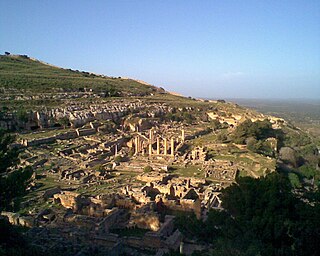
Cyrene was an ancient Greek and later Roman city near present-day Shahhat, Libya. It was the oldest and most important of the five Greek cities in the region. It gave eastern Libya the classical name Cyrenaica that it has retained to modern times. Located nearby is the ancient Necropolis of Cyrene.
Simeon is a given name, from the Hebrew שמעון, usually transliterated as Shimon. In Greek it is written Συμεών, hence the Latinized spelling Symeon.
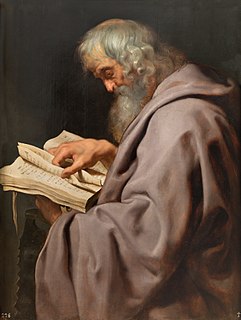
Simon the Zealot or Simon the Canaanite or Simon the Canaanean was one of the most obscure among the apostles of Jesus. A few pseudepigraphical writings were connected to him, but Saint Jerome does not include him in De viris illustribus written between 392 and 393 AD.
The Church of Antioch was one of the five major churches of the pentarchy in Christianity before the East–West Schism in 1054, with its primary seat in the ancient Greek city of Antioch.
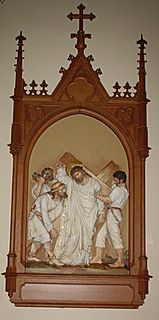
Simon of Cyrene was the man compelled by the Romans to carry the cross of Jesus of Nazareth as Jesus was taken to his crucifixion, according to all three Synoptic Gospels. "And as they came out, they found a man of Cyrene, Simon by name: him they compelled to bear his cross." He was also the father of Rufus and Alexander.
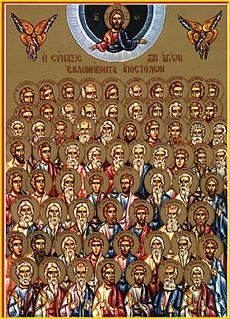
The seventy disciples or seventy-two disciples were early emissaries of Jesus mentioned in the Gospel of Luke. According to Luke, the only gospel in which they appear, Jesus appointed them and sent them out in pairs on a specific mission which is detailed in the text.
Charles William Kerr was an American Presbyterian clergyman who served as pastor of First Presbyterian Church in Tulsa, Oklahoma from 1900 to 1941. Kerr was the first permanent Protestant Christian pastor in Tulsa, arriving in 1900.

Manahen was a teacher in the first century Christian Church at Antioch who had been 'brought up' with Herod Antipas.
There are several saints named Rufus, of which the Roman Martyrology records ten; historical mention is made of the following ones, which have liturgical feasts:
- On 19 April, a group of martyrs in Melitene in Armenia, one of whom bears the name of Rufus. These martyrs are mentioned already in the Martyrologium Hieronymianum.
- On 1 August, Rufus, with several companions who, according to the most reliable manuscripts of the "Martyrologium Hieronymianum" died at Tomi, the place being afterwards by mistake changed to Philadelphia.
- On 27 August, two martyrs named Rufus at Capua -- one, whose name also appears as Rufinus in the "Martyrologium Hieronymianum". The other is said to have suffered with a companion, Carponius, in Diocletian's persecution circa 304 AD.
- On 25 September, several martyrs at Damascus, among them one named Rufus.
- On 7 November, a Rufus of Metz, who is said to have been Bishop of Metz; his history, however, is legendary. His name was inserted at a later date in an old manuscript of the "Martyrologium Hieronymianum"(ed. cit., 140). In the ninth century his relics were transferred to Gau-Odernheim in Hesse, Diocese of Mainz.
- On 12 November, Rufus, legend, without any historical proof, the supposed first Bishop of Avignon, who is perhaps identical with Rufus, the disciple of Paul. [cf. Louis Duchesne, "Fastes épiscopaux de l'ancienne Gaule", I, 258; Duprat in "Mémoires de l'Académie de Vaucluse" (1889), 373 sqq.; (1890), 1 sqq., 105 sqq.].
- On 21 November, Rufus the disciple of the Apostles, who lived at Rome and to whom Saint Paul sent a greeting, as well as he did also to the mother of Rufus. St. Mark says in his Gospel that Simon of Cyrene was the father of Rufus, and as Mark wrote his Gospel for the Roman Christians, this Rufus is probably the same as the one to whom Paul sent a salutation [cf. Cornely, "Commentar. in Epist. ad Romanos", 778 sq.].
- On 28 November, a Roman martyr Rufus, probably identical with the Rufinianus who was buried in the Catacomb of Generosa on the Via Portuensis, and who is introduced in the legendary Acts of the martyrdom of St. Chrysogonus.
- On 18 December, the holy martyrs Rufus and Zosimus, who were taken to Rome with St. Ignatius of Antioch and were put to death there for their unwavering confession of Christianity during the persecution of Trajan. St. Polycarp speaks of them in his letter to the Philippians.

In Christianity the figures widely recognised as prophets are those mentioned as such in the Old Testament and the New Testament. It is believed that prophets are chosen and called by God.
Lucius of Cyrene was, according to the Acts of the Apostles, one of the founders of the Christian Church in Antioch, then part of Roman Syria. He is mentioned by name as a member of the church there, following the account King Herod's Death:
In the church at Antioch there were prophets and teachers: Barnabas, Simeon called Niger, Lucius of Cyrene, Manaen and Saul.
Hellenistic Judaism was a form of Judaism in classical antiquity that combined Jewish religious tradition with elements of Greek culture. Until the fall of the Western Roman Empire and the early Muslim conquests of the eastern Mediterranean, the main centers of Hellenistic Judaism were Alexandria in Egypt and Antioch in Syria, the two main Greek urban settlements of the Middle East and North Africa region, both founded at the end of the fourth century BCE in the wake of the conquests of Alexander the Great. Hellenistic Judaism also existed in Jerusalem during the Second Temple Period, where there was conflict between Hellenizers and traditionalists.

The Ethiopian eunuch is a figure in the New Testament of the Bible; the story of his conversion to Christianity is recounted in Acts 8.
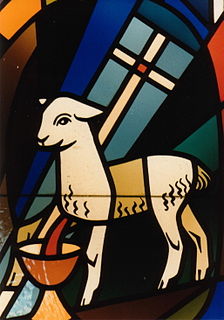
The following outline is provided as an overview of and topical guide to Christianity:
Semaan is a Christian surname mainly found in the Levant area of the Middle East. It is derived from the Semitic root word/verb sema or shema, which means “to hear”; thus, the meaning of Semaan becomes “the one who hears or listens” in both Syriac Aramaic and Arabic. Its equivalent in Hebrew is שִׁמְעוֹן, which also has the same meaning. The Greek transliteration is Σιμων (Simon) or Συμεών (Symeon), and, when Latinized, it becomes Simon or Simeon.

Saint Peter also known as Simon Peter, Simeon, Simon, Cephas, or Peter the Apostle, was one of the Twelve Apostles of Jesus Christ, and one of the first leaders of the early Church.

Acts 13 is the thirteenth chapter of the Acts of the Apostles in the New Testament of the Christian Bible. It records the first missionary journey of Paul and Barnabas to Cyprus and Pisidia. The book containing this chapter is anonymous but early Christian tradition uniformly affirmed that Luke composed this book as well as the Gospel of Luke.

The names Simon and Simeon appear 71 times and 8 times in the New Testament, respectively. Simon was a very common given name in the historical period and region of Jesus, but surnames were still very rare. It is therefore not always clear which person these names refer to, and whether some refer to the same person or distinct characters, which has led to confusion. Therefore, Christian authors and modern scholars have given these men names based on their known attributes.
References
- ↑ Acts 13:1
- ↑ Kistemaker, Simon J. (1990). Acts. Baker Book House. p. 454.